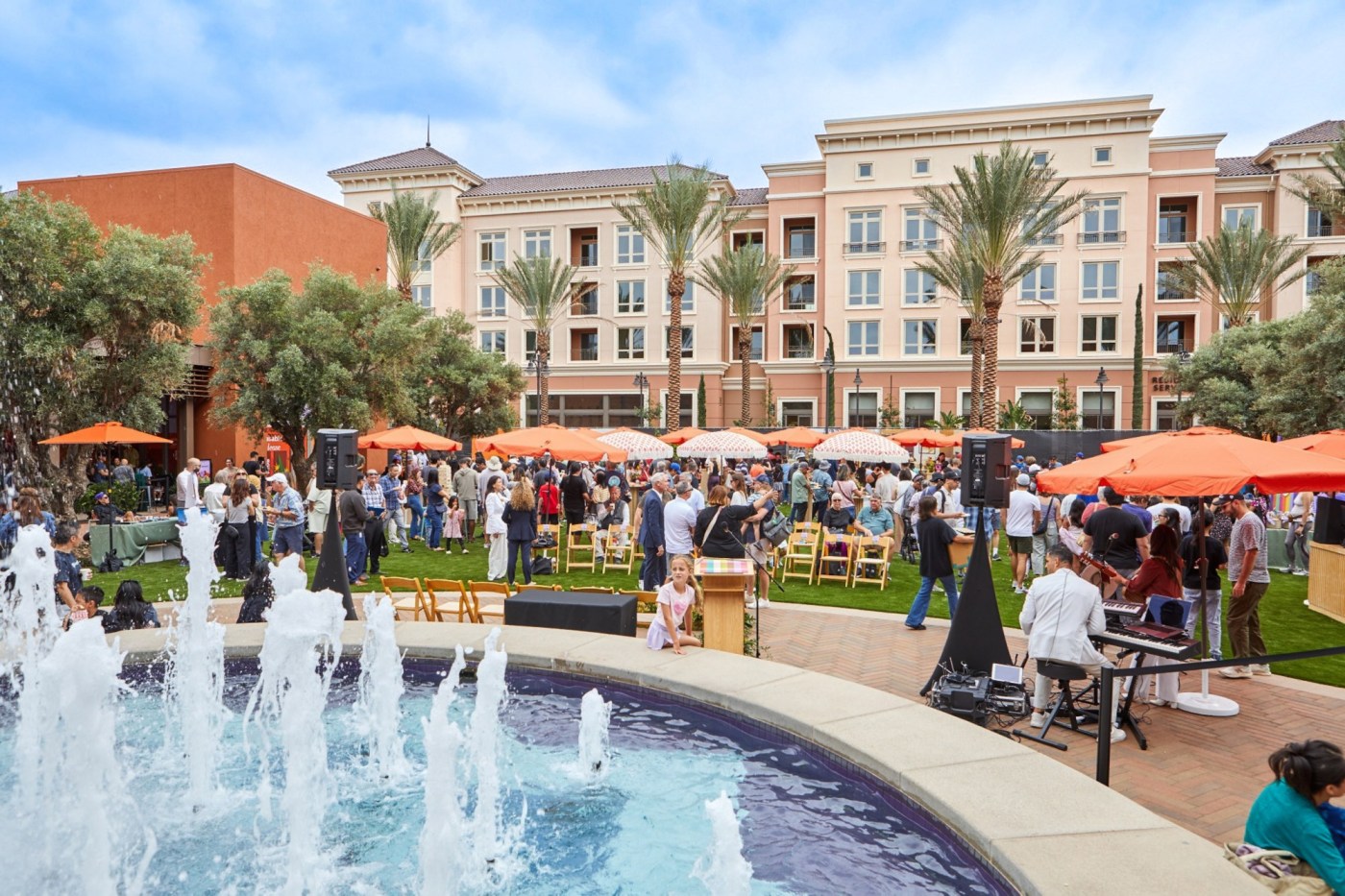California real estate giant Irvine Co. is in the midst of a building push in one hotspot for future development statewide: apartments in less-than-traditional spaces.
The Newport Beach-based company, which owns 125 complexes with 65,000 apartments across California, has 3,000 units under construction at three sites in Orange County. There are another 9,000 units in various stages of planning in Orange, San Diego and Santa Clara counties. Irvine Co. would rank 12th among the nation’s top U.S. apartment owners if it participated in the National Multifamily Housing Council scorecards.
Irvine Co.’s construction activity contrasts with a national cooldown in apartment development.
High financing costs, a wobbly economy, flat rents and overbuilding in certain markets nudged many other developers to cancel or delay rental projects. In California, apartment construction – as measured by multifamily permits – is down 25% over the past two years to a pace not seen since 2013-14.
But Irvine Co. owner Donald Bren, the nation’s wealthiest real estate investor, frequently uses unconventional thinking. For example, he restarted home construction in 2009 – well before others had the nerve to build after the real estate market collapsed into the Great Recession.
The 93-year-old’s confidence in making against-the-grain bets stems from a long-term focus as both a developer and owner. Irvine Co. has created a diverse California-centric portfolio of residential, retail, entertainment, recreation and business properties.
Bren is a pioneer in what the industry calls master planned communities, where entire neighborhoods have long-range blueprints for development. Treating real estate as a multidecade investment helps to make real-time economic gyrations seem like a modest detail in the creation of new properties.
“Fulfilling the vision of master planning has been a lifetime dedication and lifetime passion,” Bren said in a statement provided to the Southern California News Group. “I am hopeful the heritage of our stewardship will live on in many new ways.”
Life in hubs
With vacant land tricky to find, Irvine Co., like other developers, is busy swapping spaces for offices, warehouses or shopping centers into residential development.
But in 2025, few builders are executing a rental expansion at the Irvine Co.’s pace. Last year’s NMHC developer rankings showed only 13 U.S. companies building more than 3,000 apartments, which is what Irvine Co. is currently constructing.
In Orange County, Irvine Co. has 1,481 apartments under construction on two parcels previously slated for office space near the Irvine Spectrum shopping center. There’s a 313-unit expansion of an existing complex next to the Great Park nearing completion. Plus, 1,858 units are planned for another Spectrum site previously designated for commercial use.
Also, 2,500 apartments are in the works within UC Irvine’s office-oriented Research Park. Roughly 900 units are planned for the mixed-use Newport Center area. Additionally, 1,336 rentals will be built on a rare land purchase by Irvine Co. in Tustin.
Then there’s excess retail space being utilized, too, with 1,261 apartments now pre-leasing at Irvine’s Market Place shopping center.
In the Bay Area, the company recently won approval for 1,792 apartments in the Santa Clara Park project, which would replace offices just a short walk from its Santa Clara Square mixed-use complex.
And in San Diego, 552 apartments are being designed to fit within an existing office campus near the University Town Center.
Period of rethinking
The Irvine Co.’s canvas has changed.
The developer is known for transforming its massive Irvine Ranch land over the past half-century into much of the city of Irvine, regarded as one of the nation’s top places to live.
However, those raw acres are now largely developed. Irvine Co., like many California real estate firms, must get creative in a state that lacks easily developable land in its population centers.
Economic change also compels extra rethinking. Remote work’s popularity casts a shadow on the future of office properties. Online shopping dings the profitability of retail locations. All these challenges intersect with California’s push for more housing.
Irvine Co. adapted by altering its apartment game. Look at the Market Place, a 130-store shopping center just off the 5 Freeway straddling Irvine and Tustin.
A row of shops was demolished to make way for a new apartment complex. The first of those rentals is now being pre-leased.
But a more modest construction effort at the site is an example of Irvine Co.’s commitment to better melding diverse real estate types.
A smaller set of stores directly between the new apartments and the shopping center’s movie theater was torn down and rebuilt, just yards away. Adding 6,200 square feet of turf, bookended by shops, produced a smooth transition between housing and the center’s amenities.
“To create space to blend the retail and the apartments together is the thing we’re most excited about,” Rob Elliot, the company’s senior vice president for planning and design, told me.
An enthusiastic response at the grand opening tells Elliot, “People are hungry for those kinds of spaces.”
The guidepost
Various economic and social pressures mean California’s mixed-use developments must evolve.
Simply dividing land into three walled-off purposes – homes, shops, offices – or slapping retail on the bottom of residential or commercial spaces is out. Integrating properties so folks can easily move between housing, work, and play seems to be the secret sauce.
Irvine Co. insiders view Santa Clara Square as their guidepost to this new phase of mixed-use planning.
Example of Irvine Co. mixed-use development include the Santa Clara Square project in Santa Clara, Calif. (Courtesy: Irvine Co.)
The company, with nudges from Santa Clara officials, began acquiring a collection of aging, low-rise business park properties off Highway 101 in 2013.
Over the past decade-plus, buildings have been demolished and transformed into 1,800 apartments, 28 stores and restaurants, and 1.7 million square feet of offices. All that took place inside a 100-acre site, which was a learning curve for Irvine Co., used to large parcels of land.
The project’s spice lies in its walkability. No fences separate the various properties, which are dotted with paths and parks that feature 100 mature trees that were either retained or relocated on the site.
“The street is narrow enough so that it encourages pedestrian movement between the office and the retail and the apartments,” Elliot said.
Curious synergy
Irvine Co. can act differently because it is different.
It’s completely owned by Bren, estimated to be worth around $19 billion. Unlike other real estate firms that are often handcuffed by the short-term demands of Wall Street or bankers, Bren’s singular control allows his company the luxury of patient thinking.
And in a real estate world where most companies are niche specialists – focused on just one slice of the property market – Irvine Co. is a multidisciplinary builder and operator.
This means the planning of mixed-use projects can be managed under one umbrella. Its concentrated competitors can be challenged to work across property types.
But it’s not just the broad portfolio. There is a curious synergy between Irvine Co. customers – employers, shopkeepers, renters or homebuyers.
“Businesses are demanding office campuses connected to retail and housing so they can attract employees back to the office,” Elliot said.
And what merchant doesn’t want more shoppers nearby?
Yet putting housing in business districts is more than juggling assets. The live-work-play neighborhood has consumer appeal, too.
“It’s just a different opportunity,” Elliot said. “There’s quite a group, particularly younger people, looking for that kind of living environment.”
Jonathan Lansner is the business columnist for the Southern California News Group. He can be reached at [email protected]
Related Articles
State audit calls out UC, CSU student housing and says $89 million should not be used for SJSU’s Spartan Village
San Jose property sale: Single-family residence sells for $2.2 million
What $1,565,000 bought on Corbin Street: An Alameda County home
Glock ban, slavery reparations, ICE agent masks, more housing: 10 key bills Gov. Gavin Newsom signed into law
Palo Alto property sale: Detached house sells for $2.5 million
Related Articles
Amid soaring evictions, Bay Area city gets a state housing grant and a designation that could lead to new solutions
New California law restricts HOA fines to $100 per violation, giving homeowners a break
Is it better to rent or own in California? That depends.
Californians pay ninth-highest HOA fees in US
For 27% of California tenants, rent is more than half their income





